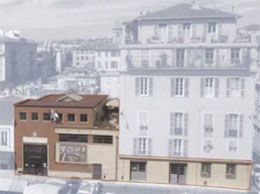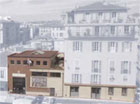
“The wealth of this exhibition lies in its great diversity,” assures Alain Philippe, deputy mayor in charge of urban planning. And indeed, the curious visitor as well as the professional architect enjoy with the same pleasure this walk between giant panels and models, jumping from a baroque church to a modern hotel, from the old town to the Observatory hill.
A small criticism, however. By focusing too much on the monuments, the exhibition tends to forget the men and women who lived there. There are too few details on the patrons, the workers, the users… We barely learn that the Church of St Roch was intended to protect peasants from the plague.
The Heritage of Nice Across the Ages
The exhibition focuses on monuments classified or listed in the Historical Monuments Inventory. But it is sometimes good to remember that the region did not wait for its attachment to France to emerge from Prehistory…
Very early on, the County of Nice became aware of the richness of its heritage. Evidence of this is the numerous monuments that were created and protected by wealthy families from Nice, like the De Gubernatis, to name only them. The Chapel of the Holy Sepulchre was destroyed during the siege of 1691, and rebuilt before the end of the following century. Another clear proof: the works from the Sardinian era to restore the Trophy of Augustus in La Turbie.
Nevertheless, in 1860, the Institution of Historical Monuments, created 30 years earlier, became interested in Nice. The preservation of heritage was organized, but more importantly, institutionalized. At the time very much in vogue, ancient monuments were the first to benefit from this protection. The Arenas of Cimiez were classified as early as May 13, 1865, despite, it is true, some errors… The frigidarium of the northern baths was called the Temple of Apollo! The identification of a public place is, however, correct.
The classification of baroque buildings came later, followed by renewed attention due to losses in the two world wars. But the 1970s were marked by massive destruction for the benefit of developers. The Ruhl Hotel, gone in 1979, fell victim to the difficult coexistence between heritage and housing. The wave of protest that followed allowed many buildings to be listed and saved. The most recent, the Negresco Hotel in 2003, the Hall of the old South Station in 2005, and last year, the new synagogue as well as the “archaeological crypt” revealed by the tramway works.
More Information
The exhibition “Nice: Living the Historic Monuments,” at the Forum on Urban Planning and Architecture, Place Pierre Gautier (Cours Saleya), welcomes you until September 27. Admission is free. The Forum is open from Monday to Friday, from 8:30 am to 5:30 pm, and Saturday from 9 am to 1 pm.
We recommend the very beautiful catalog, a practical dictionary for anyone from Nice curious about their city. Enjoy your visit!
This video is from the site Web TV Nice



